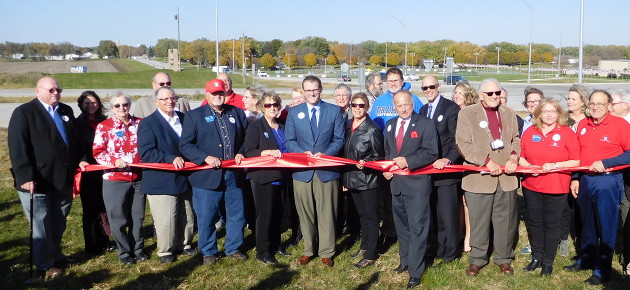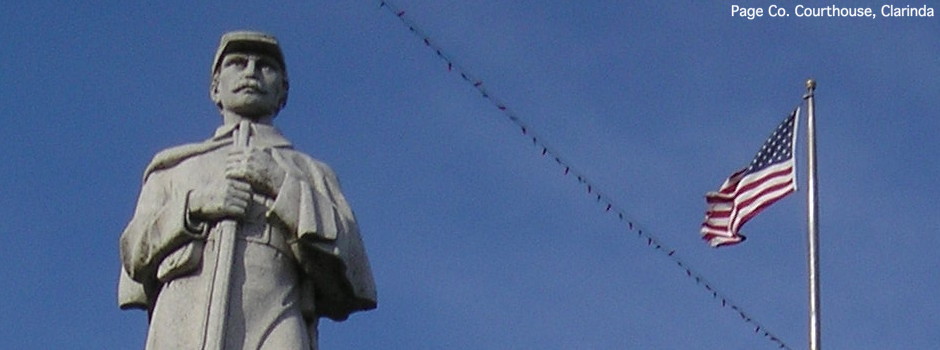
October 19, 2018: Acting Lt. Gov. Adam Gregg (center) holds the ribbon to mark the completion of four-lane US 20 along with a host of government officials and members of the US 20 Corridor Association.
Holstein, Iowa, October 19 — Lorraine Jepsen was there at the beginning.
Some of her Hinkhouse family land was used for the construction of a new alignment of US 20 along the section line five miles west of Correctionville in the 1950s. It was a replacement for concrete that had just turned 30 years old itself, thanks to Woodbury County’s aggressive early paving efforts.
After the road was graded, her family would ride horses and a Mexican burro named Kate on it. In the summer of 1958, they watched it get paved, “and that was our entertainment.”
When that section was completed — three miles of four-lane east of Moville plus a new two-lane road nearly all the way to Holstein — a worker with the Iowa Highway Commission said they’d be back in “10 years or so” to get more land for the other two lanes.
“Ten years or so” later, give or take a half-century, it finally happened, and Jepsen was there at the end. A packed crowd at the new Boulders Inn and Suites in Holstein celebrated the completion of a four-lane US 20 from Dubuque to Sioux City. It was a project long promised but achieved only through the persistence of dozens of Iowa residents for dozens of years.
US 20 between Correctionville and Holstein, which opened Wednesday, was the last link. Two other segments, Early to Holstein and Moville to Correctionville, opened earlier this fall. Twenty-four miles east of Early opened in 2012, on a day that was even more windy than Friday.
Acting Lt. Gov. Adam Gregg, a northwest Iowa native, expressed appreciation for the project on behalf of both himself and Gov. Kim Reynolds, who did not attend in order to be at a Des Moines political rally featuring Vice President Mike Pence announced earlier in the week. “I can sum up today in one word — finally,” Gregg said.
Iowa DOT Director Mark Lowe said that four and a half hours into his job, Gov. Terry Branstad summoned him to talk about the budget and finishing Highway 20. He said Branstad asked about how “to raise the revenue needed” to finish the job. Most of Friday’s speakers avoided using the phrase “gas tax” although it was an increase in the gas tax that made today possible.
Over and over, speakers noted the team effort it took to finish the four-lane, including from some people who had died before they could see their work come to fruition.
U.S. Rep. Steve King, R-Kiron, said he worried the project would lose leverage after 20 was completed to Fort Dodge but the support stayed strong. He mentioned that right before earmarks were banned in Congress, he made sure funding would go toward environmental and archaeological work on the corridor west of US 71 so the project would be “shovel ready.”
For Iowa Transportation Commissioner Charese Yanney, the day was personal. Yanney’s aunt and three other people died at the intersection of US 20 and 59, right outside the hotel, and from that point on the family had a mission to make the highway safe. (That crash is likely why a couple miles of 20/59 got four-laned back in 1964.)
Outside the hotel, dignitaries of various groups took their turns cutting the ultimate ribbon for Highway 20.
The afternoon’s celebration continued with a “Taste of 20” that included two famous Iowa food companies, Cookies BBQ Sauce of Wall Lake and Wells Blue Bunny of Le Mars, and a batch of local providers from the US 20 corridor west of Fort Dodge. Tiefenthaler Quality Meats of Holstein provided multiple samples, as did Noble Popcorn of Sac City. Attendees were invited to Holstein’s Oktoberfest that night downtown.
The Fort Dodge Messenger and Ida County Courier/Holstein Advance printed special sections to celebrate. The Messenger’s section includes a timeline from the US 20 Association, which was also used in the Des Moines Register’s coverage. If the association used Jason Hancock’s Iowa Highways Page website, which includes my research, then I can say I had my own little part in this historic day.
Further coverage: Messenger, Iowa Public Radio, Sioux City Journal, KTIV, and a Waterloo Courier article from 1997 that shows some the committee’s determination to get this project seen through.
